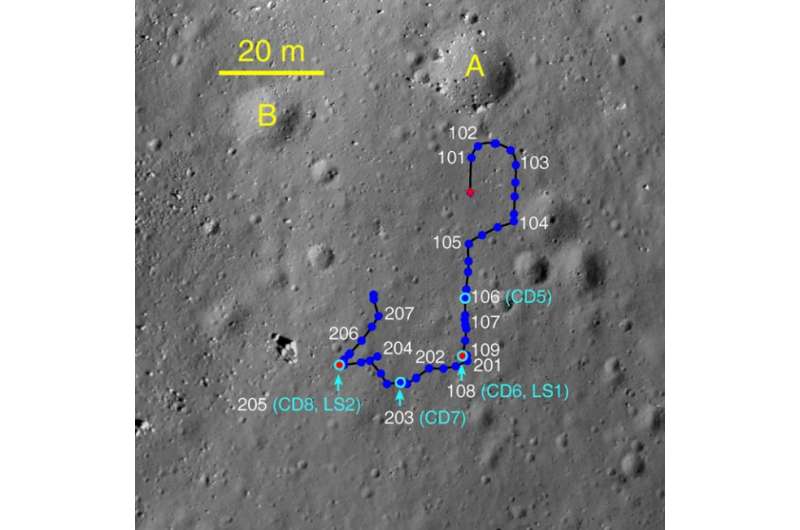April 22, 2015 report
Immobilized Yutu rover still providing valuable lunar data (Update)

(Phys.org)—The Chinese Chang'e 3 mission to the moon successfully landed and deployed the Yutu rover in December 2013. Although the rover experienced operational difficulties after 14 days, it is still gathering and transmitting useful lunar data.
The lander and rover are located in the basin of the Mare Imbrium, the second-largest lunar mare after the Oceanus Procellarum. Recently, a collaborative of researchers from a number of Chinese science institutions published a paper in the Proceedings of the National Academy of Sciences analyzing data collected by the Chang'e 3 mission that reveals the volcanic history of the northeastern part of the Imbrium basin.
KREEPy territory
Apollo 15 landed in the eastern Imbrium in August 1971, on the surface of an old basalt unit with low concentrations of TiO2. The Chang'e 3 hardware touched down on a young basalt unit with high Ti concentrations, the result of a later lava flow.
The moon's basins were formed around 3.9 billion years ago, likely during the late heavy bombardment, after which they were filled by lava flows around 3.1 to 3.8 billion years ago. The composition of the Imbrium basin is described by the acronym KREEP, comprising potassium (K), rare earth elements (REE) and phosphorous (P). The presence of these KREEPy materials is indicated by high concentrations of radionuclides uranium, thorium and potassium. This terrain is considered to be the last residual melt of the Lunar Magma Ocean.
The Yutu Rover is equipped with a lunar penetrating radar system, which was used to conduct a 114-meter-long profile of the basin surface. It measured a thickness of about five meters of the lunar regolith and detected three underlying basalt units at depths of 195, 215 and 345 meters.
A recipe for lunar soil
Additionally, during its first two months on the moon, the Yutu rover carried out a pair of analyses with an active particle-induced X-ray spectrometer that revealed the chemical composition of the lunar soil, with clear peaks of magnesium, aluminum, silicon, calcium, titanium, potassium, chromium, iron, strontium and zirconium. It also detected yttrium and niobium.
The two analyses were carried out at separate locations, and produced nearly identical results. The authors note that the gap in TiO2 measurements in basalt units between the Yutu rover's territory and other mare probably indicates a distinct type of basalt.
The unique chemical composition of the basin suggests a pair of possibilities for past volcanic activity. The researchers write, "A scenario is that the basalt was derived via partial melting of ilmenite-rich mantle reservoir and then contaminated by the residual KREEP later beneath the ferroan anorthosite crust as it ascended to the surface. Alternatively, the basalt was formed via partial melting of a mantle reservoir that had mixed with sinking dense ilmenite-rich KREEPy rock."
An abundance of rock
Via an onboard short-wave infrared spectrometer, Yutu made four reflection spectra analyses, and the researchers find that the results are very similar to those from Apollo 15. The mineral composition in the Mare Imbrium is similar to Apollo mare soils.
The lunar penetrating radar data analyzed the basalt units at the Chang'e 3 landing site; the LPR echoes exhibit an uneven bottom of the lunar regolith with a depth varying between 2.3 to 5.4 meters. The authors note that the regolith layer thickness at the landing site could be considered to be the minimum of the global surface, as its chemical and topographic features indicate that it is young.
The 5.4 meter depth reading was larger than expected; the authors write, "Such a thick lunar regolith layer is unlikely attributed to ejecta deposits from a nearby crater because no significant modification on the surface was observed in the high-resolution images taken by the descending camera… Our LPR imaging results show that the thickness of the global lunar regolith layer was underestimated in previous studies."
More information: "Volcanic history of the Imbrium basin: A close-up view from the lunar rover Yutu." PNAS 2015 ; published ahead of print April 13, 2015, DOI: 10.1073/pnas.1503082112
Abstract
We report the surface exploration by the lunar rover Yutu that landed on the young lava flow in the northeastern part of the Mare Imbrium, which is the largest basin on the nearside of the Moon and is filled with several basalt units estimated to date from 3.5 to 2.0 Ga. The onboard lunar penetrating radar conducted a 114-m-long profile, which measured a thickness of ∼5 m of the lunar regolith layer and detected three underlying basalt units at depths of 195, 215, and 345 m. The radar measurements suggest underestimation of the global lunar regolith thickness by other methods and reveal a vast volume of the last volcano eruption. The in situ spectral reflectance and elemental analysis of the lunar soil at the landing site suggest that the young basalt could be derived from an ilmenite-rich mantle reservoir and then assimilated by 10–20% of the last residual melt of the lunar magma ocean.
Journal information: Proceedings of the National Academy of Sciences
© 2015 Phys.org





















